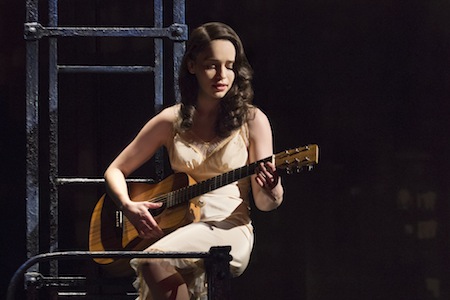Breakfast at Tiffany’s -- Send It Back
Breakfast at Tiffany’s
Cort Theater
138 W. 48th Street
New York, N.Y.

Emilia Clarke as Holly Golightly.
Anyone sitting in the Cort Theater in New York waiting for Breakfast at Tiffany’s to begin enjoys a wonderful montage of paintings and photographs of the city during World War II to remind you that the play is set in 1943. After ten or fifteen minutes of this luscious buildup, you are ready for a memorable play.
You don’t get one, though. You should send Breakfast at Tiffany’s back to the kitchen and try another restaurant.
The stage version of Breakfast at Tiffany’s, adapted for the theater by Richard Greenberg and based on the incredibly successful 1961 movie starring Audrey Hepburn, has lost its luster. The executives at Tiffany’s should ask that they rename the play Lunch at Cartier’s
Now, let’s be kind. No one can replicate Audrey Hepburn’s phenomenal Oscar-nominated performance as the flighty, scatterbrained Holly Golightly in the film, the slightly off-balance, beautiful young woman who takes New York by storm in a dizzy, underhanded way. And how do you reproduce the magical wonder of the story without Henry Mancini’s title song. Moon River, one of the very best tunes ever written?
There are more problems with this show than there are diamonds at Tiffany’s, and there are thousands of diamonds at the pricy Fifth Avenue store.
It is supposed to be an historical play. The 1958 novella by Truman Capote was set in 1943, but moved up to 1961 for the film. The pre-play image montage conjures up 1943 and you are told the play is set in that year. Other than 1940s clothing and two faint references to the war, you would think the play took place in 2007. New York City was a hotbed of wartime activity in World War II, from espionage to Nazi submarines in the nearby waters to the big naval yards and long chain of USO centers where soldiers and sailors socialized. That would have been a nice backdrop for this dreary, tedious play.
Holly Golightly is one of the great female characters in entertainment history, but actress Emilia Clarke does not try to play her. She is too busy playing Audrey Hepburn and fails badly at it. She is also trying to develop a deep Southern accent but does not get much further south than Philadelphia. Ms. Clarke, as fantasy literature fans knows, is one of the stars of the very successful HBO series Game of Thrones. She plays the daughter of deposed King Aerys Targaryen. The rebels who ousted him exiled her to a dark, lonely, Mongolian steppe-like world. She should have remained there. The other actors in the play are equally dreary, even George Wendt (Cheers), who plays Joe Bell, a stumbling, bumbling bartender.
Holly Golightly was a semi-prostitute (Capote always argued that she was not a hooker, just a girl who was very grateful to men who gave her money). The book and movie’s story was her efforts to square that with her past and her eventual love for her neighbor (played here by Cory Smith, who is half asleep throughout the entire play). She flirts with gangsters, drug dealers and Brazilian millionaires. In the book and film, her boyfriend/neighbor grappled with the fact that he was a paid male lover for a married New York woman, but that is not in the play, either (nor, from the book, is his homosexuality). This is a plodding, dull, uneventful drama that drags through two and a half hours of time in which much New York City and American history could have been told -- and was not. Audrey Hepburn is turning over in her grave, sunglasses, cigarette holder and all.
There might have been one saving grace to the play, though. Everybody says a dog or cat can save the show and this play had one, an adorable long haired tabby cat named ‘cat.’ When last seen in act two, he was running for the exits.
Breakfast at Tiffany’s an historical miscue, is just a stale snack at your local department store, with its electricity out.
PRODUCTION; The show is produced by Colin Ingram and Donovan Mannato, Geoffrey Thomas and Dominic Ianno. Sets: Derek McLane, Costumes: Colleen Atwood. Lighting: Peter Kaczorowski, Make Up: Roy Helland. The play is directed by Sean Mathias. Open ended run.
